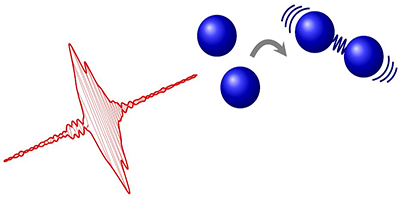July 7, 2015 report
Researchers build molecules using a laser beam

(Phys.org)—A combined team of researchers from Israel's Hebrew University and Technion-Israel Institute of Technology and Germany's Universität Kassel has succeeded in demonstrating coherent control of bond-forming between atoms using a laser beam. In their paper published in Physical Review Letters, the team describes their experiments with molecule-making and outlines future possible applications.
For many years chemists and physicist have been looking at ways to control chemical reactions with coherent light delivered via lasers. To date, progress has been made in using lasers to selectively cut atoms apart by manipulating the electron bonds that hold them together. Attempting the reverse has not gone so well—until now, there has not been a way to create a molecule by using a laser beam to manipulate the bonds that would tie atoms together in a way they had planned. In this new effort, the researchers have succeeded in doing just that, albeit in just one type of scenario.
To create molecules, the team shot very short pulses of laser light at a small group of magnesium atoms, causing the formation of some amounts of the magnesium dimer Mg2. The team found that they could cause more of the molecules to come about by altering the pulse shape—in one instance they were able to increase the yield by a factor of five. Recognizing that a laser pulse of sufficient intensity would cause bonding, the team used calculations to show that the yields they obtained came about due to coherent control, rather than random chance and then proved it by conducting further experiments. The researchers note that the process does not produce yields of 100 percent because the orientation of the electrons of two atoms must be the same when the laser light strikes in order to cause them to bond.
The results by the researchers show that coherent control of bond-making between atoms using a laser beam is possible, which will likely kick off new research efforts by others. If the process can be refined further, the team suggests, it could very well lead to a great reduction in chemical processing costs as part of manufacturing efforts and possibly create a whole new type of photochemistry.
More information: Coherent Control of Bond Making, Phys. Rev. Lett. 114, 233003 – Published 10 June 2015 . dx.doi.org/10.1103/PhysRevLett.114.233003 . On Arxiv: arxiv.org/abs/1411.1542
ABSTRACT
We demonstrate coherent control of bond making, a milestone on the way to coherent control of photoinduced bimolecular chemical reactions. In strong-field multiphoton femtosecond photoassociation experiments, we find the yield of detected magnesium dimer molecules to be enhanced for positively chirped pulses and suppressed for negatively chirped pulses. Our ab initio model shows that control is achieved by purification combined with chirp-dependent Raman transitions. Experimental closed-loop phase optimization using a learning algorithm yields an improved pulse that utilizes vibrational coherent dynamics in addition to chirp-dependent Raman transitions. Our results show that coherent control of binary photoreactions is feasible even under thermal conditions.
Journal information: Physical Review Letters , arXiv
© 2015 Phys.org





















